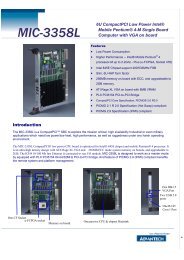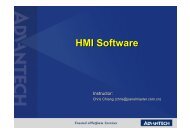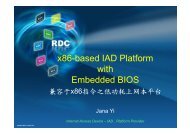industrial wireless book special edition - Networking ...
industrial wireless book special edition - Networking ...
industrial wireless book special edition - Networking ...
Create successful ePaper yourself
Turn your PDF publications into a flip-book with our unique Google optimized e-Paper software.
6LoWPAN<br />
node<br />
Router solicitation<br />
Router advertisement<br />
Node registration<br />
Node confirmation<br />
Fig. 2. 6LoWPAN ND message exchanges<br />
6LoWPAN<br />
node<br />
All nodes in a 6LoWPAN register with Edge<br />
Routers (ERs), which are on the border to other<br />
IP networks. It is assumed that the nodes are<br />
reachable by the Edge Router either by direct<br />
radio link or via 6LoWPAN routers. Nodes that<br />
cannot reach any Edge Router, may be<br />
configured to form an ad-hoc LoWPAN by<br />
configuring one to act as an Edge Router. A<br />
typical registration exchange between a host<br />
and router is shown in Fig. 2.<br />
These Edge Routers keep track of the nodes in<br />
their network, and are able to perform duplicate<br />
address detection, address resolution and short<br />
address generation on behalf of nodes across<br />
the entire 6LoWPAN network island.<br />
In addition, advanced features are provided<br />
for building large subnets including multiple<br />
Edge Routers handling large numbers of nodes.<br />
This technique is not only limited to infrastructure<br />
based networks, and can also be<br />
applied in isolated ad-hoc networks. All nodes<br />
in a LoWPAN have a unique IPv6 address (or<br />
possibly several), which does not change while<br />
the node is attached to the same or extended<br />
LoWPAN. This allows for efficient mobility<br />
within a LoWPAN and good manageability of<br />
nodes from outside the LoWPAN.<br />
Finally, 6LoWPAN ND also includes fault<br />
detection techniques such as the use of<br />
secondary Edge Routers when the primary Edge<br />
Router fails or becomes unreachable. Moreover,<br />
mobile 6LoWPAN nodes can move between Edge<br />
Routers in the 6LoWPAN network, when the<br />
serving Edge Router becomes unreachable.<br />
Network example<br />
Here follows a Building Automation example<br />
of how 6LoWPAN can be used to build different<br />
kinds of practical networks. The same principles<br />
could be applied widely to other processes.<br />
Building Automation is an important application<br />
for <strong>wireless</strong> embedded networking,<br />
e<strong>special</strong>ly in energy efficiency and improved<br />
facility management. Applications requiring<br />
<strong>wireless</strong> networking include energy monitoring,<br />
lighting control, HVAC control, asset<br />
management, and door access control. 6LoWPAN<br />
is well suited to building automation as it<br />
provides a horizontal, reusable network for all<br />
the applications above along with the required<br />
security, scalability and mobility support.<br />
Most building automation backend systems<br />
are IP- or Web-based today, leveraging the<br />
seamless Internet integration and manageability<br />
of IPv6.<br />
Figure 3 shows a simplified example of a<br />
6LoWPAN network for building automation.<br />
Such a network would leverage the existing<br />
Ethernet infrastructure, interconnecting all the<br />
Edge Routers of a facility which make up an<br />
Extended LoWPAN. Both remote and local<br />
servers can access nodes using IPv6 or IPv4<br />
using a IPv4/IPv6 transition mechanism such<br />
as 6-to-4 tunnelling. All nodes have a unique<br />
IPv6 address, which stays the same while nodes<br />
move freely between Edge Routers in the<br />
facility. This is a crucial feature for asset<br />
management using 6LoWPAN active RF tags or<br />
IPv6 addressed sensors.<br />
Fig. 3. Building automation network example<br />
Router behaviour<br />
Edge Router: An Edge Router has both a<br />
6LoWPAN interface and a regular IPv6 interface<br />
and it is located at the junction of backbone<br />
and 6LoWPAN network. The Edge Router is<br />
responsible for Router advertisement to the<br />
6LoWPAN network, address resolution of a node,<br />
maintaining a whiteboard of IPv6 addresses,<br />
duplicate address detection for the addresses it<br />
defends, forwarding packets from one 6LoWPAN<br />
to another 6LoWPAN or data packets between<br />
the 6LoWPAN network to the backbone network.<br />
When 6LoWPAN packets are forwarded to the<br />
backbone network, the 6LoWPAN adaptation<br />
layer is stripped off, the header is uncompressed<br />
and it makes sure that global IPv6 source<br />
address is used for the outgoing packets.<br />
For incoming packets from backbone to the<br />
6LoWPAN network, it adds 6LoWPAN specific<br />
adaptation layer and possibly 6LoWPAN IPv6<br />
header compression mechanism and then<br />
forwards them to the 6LoWPAN network. Edge<br />
Router’s 6LoWPAN interface also joins the<br />
6LoWPAN_ER anycast address and it listens for<br />
Router Solicitation and Node Registration<br />
messages. The Edge router can also generate<br />
IPv6 addresses using IEEE 802.15.4 short<br />
addresses on behalf of the registering nodes.<br />
Note that the Edge Router follows standard<br />
IPv6 Neighbour Discovery procedures on the<br />
backbone IPv6 link.<br />
Backbone Router: A regular legacy IPv6 router<br />
which communicates with the backbone side<br />
of the Edge router. A backbone router is not<br />
required to recognise the Owner Address<br />
Identifier when received with NS/NA Duplicate<br />
Address Detection messages.<br />
The IPv6 backbone router may also be responsible<br />
for translating or tunnelling the IPv6<br />
packets into IPv4 networks. IPv6 backbone<br />
router may use prefix delegation to Edge<br />
routers for globally unique IPv6 addresses in<br />
6LoWPAN network. In future, more interactions<br />
between backbone routers and 6LoWPAN Edge<br />
Routers may be defined for the configuration<br />
and control of Edge Routers.<br />
6LoWPAN Router: This type of router is present<br />
in the multihop mesh topology of 6LoWPAN<br />
networks. 6LoWPAN routers are essential<br />
components of 6LoWPAN links and they forward<br />
data packets across links and relay the control<br />
packets between the Edge router and the<br />
6LoWPAN nodes. They also respond to the<br />
Router Solicitation messages from the nodes<br />
on the same link with Router Advertisements.<br />
It should run a 6LoWPAN compatible routing<br />
protocol, such as that being defined at IETF<br />
removes working group. 6LoWPAN routers are<br />
aware of the 6LoWPAN Edge Router address and<br />
may be able to forward a packet addressed to<br />
the 6LoWPAN_ER anycast address.<br />
6LoWPAN node behaviour<br />
6LoWPAN nodes are required to do very little ND<br />
signalling, and do not need to perform<br />
Duplicate Address Detection, Address<br />
Resolution, or Neighbour Solicitation. After<br />
performing boot-strapping as described in the<br />
previous section, the node needs to periodically<br />
renew its registration with one or more<br />
Edge Routers. A 6LoWPAN node forms an<br />
optimistic IPv6 link local address from the<br />
EUI64 bit unique global MAC address. It should<br />
then send a Router Solicitation to its own link<br />
router (either 6LoWPAN router or the on-link<br />
Edge Router). The 6LoWPAN node is recommended<br />
not to use multicast or broadcast<br />
address to send neighbour discovery messages<br />
in IEEE 802.15.4 networks. A 6LoWPAN node<br />
can request multiple addresses for registration<br />
and receives confirmation from the Edge<br />
router(s). Since the IPv6 address contains the<br />
EUI64 style MAC address in its lower 64 bit<br />
address, Neighbour Solicitation to the Edge<br />
Router for address resolution is not required.<br />
After successful Registration, a 6LoWPAN node<br />
sends the data packet directly to a 6LoWPAN<br />
neighbour’s address via the 6LoWPAN routers<br />
that act as default routers. The 6LoWPAN node<br />
should configure a globally unique IPv6 address<br />
through auto configuration if it wants to<br />
communicate with nodes outside the 6LoWPAN<br />
networks.<br />
Samita Chakrabarti, IP Infusion<br />
Zach Shelby, Sensinode<br />
From the IPSO Alliance paper<br />
6LoWPAN Neighbor Discovery: A Highlevel Overview<br />
www.ipso-alliance.org<br />
First published in the <strong>industrial</strong> ethernet <strong>book</strong> July 2010<br />
Internet of Things<br />
sponsored by Advantech<br />
<strong>industrial</strong> ethernet <strong>book</strong><br />
39

















